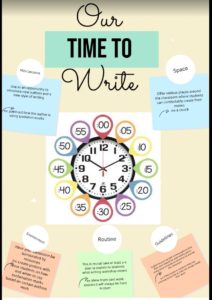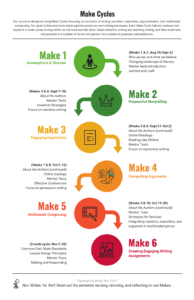Make Cycle 3
 Make Cycle 3: Engaging Expositions
Make Cycle 3: Engaging Expositions
Weeks 5 & 6: Sept 21-Oct 4
“Expository writing is a type of writing that is used to explain, describe, give information, or inform.”
For our third make cycle, we’ll be playing with expository writing. Too often in school, we give kids really boring (and quite frankly, not very useful) templates for writing “how-tos” or scripted essays. But expository writing can be informational and playful as I hope our mentor texts demonstrate in this make cycle. We will try out writing our own expository texts with options for creating video, infographics, books, or working with other ideas you may have.
If you look at the Common Core standards for ELA, you’ll notice that writing informative texts is a genre that crosses all grade levels, moving from simple texts to more complex texts. Here is the Common Core standards from grade 2 and grade 4 below:
Write informative/explanatory texts in which they introduce a topic, use facts and definitions to develop points, and provide a concluding statement or section.
Write informative/explanatory texts to examine a topic and convey ideas and information clearly.
- CCSS.ELA-LITERACY.W.4.2.A
- Introduce a topic clearly and group related information in paragraphs and sections; include formatting (e.g., headings), illustrations, and multimedia when useful to aiding comprehension.
- CCSS.ELA-LITERACY.W.4.2.B
- Develop the topic with facts, definitions, concrete details, quotations, or other information and examples related to the topic.
- CCSS.ELA-LITERACY.W.4.2.C
- Link ideas within categories of information using words and phrases (e.g., another, for example, also, because).
- CCSS.ELA-LITERACY.W.4.2.D
- Use precise language and domain-specific vocabulary to inform about or explain the topic.
- CCSS.ELA-LITERACY.W.4.2.E
- Provide a concluding statement or section related to the information or explanation presented.
Make Cycle 3 in a nutshell:
Week 5: Reading Chapters 2 & 3 from About the Authors and working with Appendix C & D.
- Wednesday, Sept 23: response to chapter 2 & appendix C due
- Sunday, Sept 27: response to chapter 3 & appendix D due (two part prompt)
Week 6: Working with expository mentor texts (Are You a Dragonfly, searching for infographics, some choices from Nerdy Book Club, and Ignite talk) and creating Make 3: Engaging expository writing
- Wednesday, Sept 30: mentor text prompt due
- Sunday, Oct 4: Make 3 due
Week 5: Sept 21-Sept 27
Read by Wednesday, Sept 23:
About the Authors: Chapter 2 (p. 23-37) and Appendix C (165-171)
Then, respond:
Prompt: Similar to last week’s work with chapter 1, point to a couple of places in chapter 2 and the appendix C that you found interesting or puzzling or both? You don’t need to quote the whole passage or passages, but give us enough info so we know what you’re talking about. Why did that section or sentence interest you? Why does the idea matter as future teachers?
Post in Make Cycle 3: Discussions (chapters 2 & 3)
Read by Sunday, Sept 27:
About the Authors: Chapter 3 (p. 38-57) and Appendix D (172-176)
Then, respond:
Part I: What are some ideas you find interesting, confusing, or that you like from chapter 3? Point us to a couple of places in the chapter (either give us a page number or a quote or explain the idea you’re referencing from the chapter) and explain why you chose that idea. Use this prompt to explore ideas you might try out in your classroom or ideas that seem daunting that you would want to know more about.
Part II: On page 176, the authors give us a list of mentor writers. Choose one of the writers from the list and do a little research: find the author’s books online (once you know their books, you can almost always find a youtube video of someone reading the book), look for their websites, and/or find interviews with the authors. What do you notice about this author’s writing that could make for interesting mentor writing for your future students? What might you highlight in the writing or use as a model? What features do you like from their work?
Post in Make Cycle 3: Discussions (chapters 2 & 3)
Week 6: Sept 28-Oct 4
Read by Wednesday, Sept 30:
Read/Watch/Search the Mentor Texts: 1) Are You a Dragonfly?, 2) Nerdy Book Club book search, 3) Infographics search, and 4) Ignite talk
Watch/Read:
Search:
Do a search for one of the recommended books from this Nerdy Book Club post: Top 10 New (2017) Informational Picture Books. Do an internet search for one of the books that looks interesting to you. You can most likely find some excerpts or a video with a read aloud of the book. (Nerdy Book Club is a site curated by teachers who share books: a great resource to bookmark for yourself.)

How about infographics? How do they convey information in more readable ways? Do a search for educational infographics: What features make an infographic useful?
Watch:
Finally, check out this Ignite talk from Marijke Hecht. Ignite talks follow a format: 5 minutes with 20 slides that auto advance every 15 seconds. The idea is to convey information or offer a provocation in a short amount of time.
What features might you borrow from the Ignite talk format to use in your own makes?
Then, respond:
Prompt: What are some features of these texts that you notice? How might we use these texts as models for our own writing? What work did the authors have to do to create these texts? What work might you need to do to write or record your expository text?
Post in Make Cycle 3: Ideas for Writing (Dragonflies, etc)
By Sunday, Oct 4: MAKE 3!
For this make, you have four options (but really, I am open if you have other ideas; just email me):

- Perhaps the story you wrote last week lends itself to being revised as an expository text? For example, you could use the Dragonfly book as a model and write a new book that has more information and facts about your story. You might also remember Josh’s “Mammoth” story from chapter 1, which is also a great model for an expository book. You could work off a story you wrote from last week OR write a new book about an idea or an animal or baking or whatever that uses the Dragonfly book as a model to work from. You most likely will have to do a bit of research to get your facts right.
- Create an Infographic about Chapters 2 or 3 of About the Authors using Piktochart. You can consider which quotes you would use, what images, etc? How might you create a visual summary of one or both of those chapters?
- Record your own Ignite talk (or TikTok video?)
One of my favorites: Check out the TikTok from Kelsey on Twitter, which does a hilarious job of explaining the Oxford comma: pic.twitter.com/PWtVOSkO77
- Finally, you could create an “instructables” video, walking us through how to do something. For example, I can bake a really good pie, so I could create a video that shows how. You would want to look through some examples from the Instructables website: https://www.instructables.com/teachers/ Then, you can create your own, upload to YouTube or Vimeo and share the link with us.
- Have another idea for an expository text? Email me.
Remember, per usual, to tell us about your process: what worked, what was challenging, how did you go about creating your expository text?
Post in Make Cycle 3: Engaging Exposition MAKES